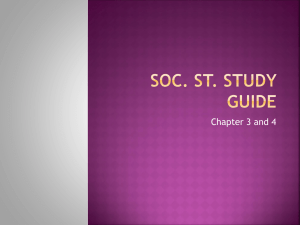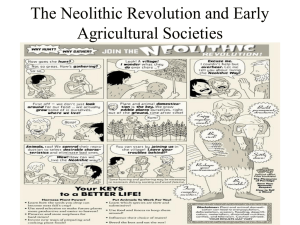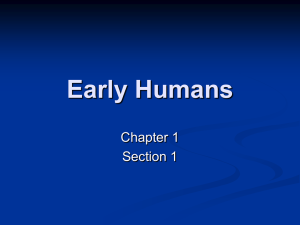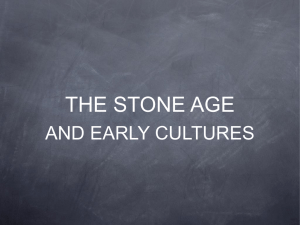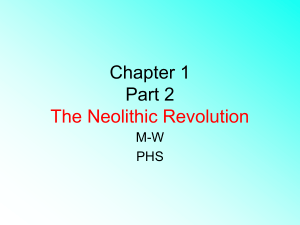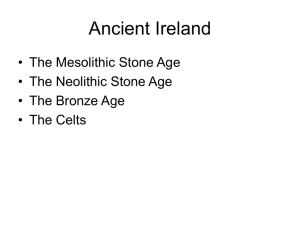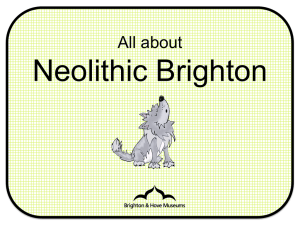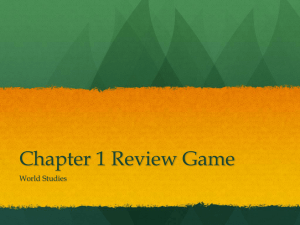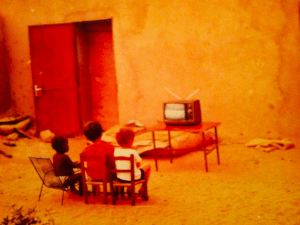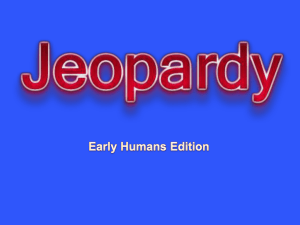File
advertisement
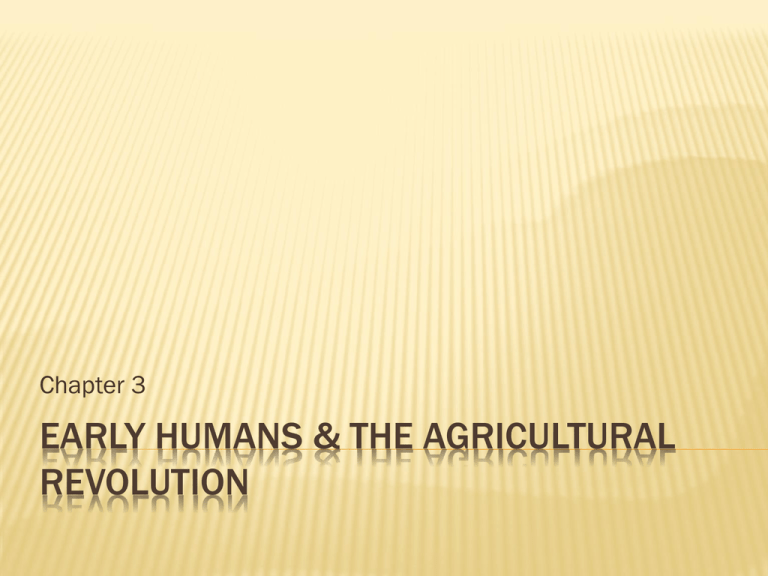
Chapter 3 EARLY HUMANS & THE AGRICULTURAL REVOLUTION OPENING ACTIVITY What do I own? What does it say about me? What do these objects say about our culture? What will it say about me 20,000 years from now? HOW HISTORIANS GET INFORMATION Archaeology is the study of the past by looking at artifacts (objects made by people) that have been left behind. They use these artifacts: tools, pottery, weapons, and jewelry to learn what life was like in the past. Paleontology is the study of fossils (the remains of plant and animal life that have been preserved from an earlier time). Anthropology is the study of human culture and how it develops over time. They study artifacts, fossils and they look for clues about what people valued and believed. PREHISTORIC ROCK PAINTING Lascaux, France 17,300 years old Discovered in 1940 by 4 teenagers rescuing their dog that fell in a ditch. EARLY HUMANS Virtual Tour of Lascaux http://earlyhumans.mrdonn.org/caveart.html Why were these images created? What do these images tell about peoples’ lives back then? ARCHAEOLOGIST DISCOVERY REPORT Date of Discovery: Location of Discovery: What colors, shapes, and materials are used in this artwork? What emotion does this artwork communicate to you? From your study of the artwork, what hypothesis can you make about prehistoric humans? Label details in the image that support your hypothesis. Explain how these details support your hypothesis? From your study of the artwork, what questions do you have about prehistoric humans? click me!!! EARLY HUMANS 8000BC-2000BC STONE AGE The early part of human history is the STONE AGE People used to make tools and weapons out of stone Started at about 2.5 million years ago PALEOLITHIC AGE This is the earliest part of the Stone Age Paleolithic=old stone So this this is called “Old Stone Age” Began 2.5 million years ago until 8000BC *Draw a time line. Label the entire timeline “Stone Age” and section a large section “Paleolithic Age (Old Stone Age)”. SURVIVING IN THE PALEOLITHIC AGE Nomads People who move from place to place to survive Traveled in groups of 20-30 members Survived by “hunting and gathering” Hunted: buffalo, bison, wild goats, reindeer, fish Gathered: wild nuts, berries, fruits, wild grains, and green plants FINDING FOOD Men hunted large animals At the beginning they used clubs or drove animals down cliffs to kill them Then, they developed tools and weapons to help them hunt (traps and spears) Women stayed close to camp (near water) Looked after children Gathered berries, nuts, and grains THE INVENTION OF TOOLS Hunting and gathering was their culture Tools and methods to perform tasks (technology) First used by Paleolithic people Sticks, stones, and tree branches were used before Learned about “flint” and creating sharp tools. THE INVENTION OF TOOLS “flint” technology was a major breakthrough for early peoples Over time they built Spears bow and arrows Harpoons Sharp tools to cut up plants Scraping tools to clean animal hides THE INVENTION OF TOOLS By the end of the Paleolithic Age, humans were making smaller and sharper tools Needles from animal bones to make nets, baskets, sew clothing Influenced farming tools and where humans settled. CHANGING TO SURVIVE Climate affected how people lived Shelters Caves Constructed tents from animal skins, brush, & wood Ice and snow shelters Large bones from dead mammoths Clothing From animal skins FIRE SPARKS CHANGES FIRE! Provided warmth Provided light Scared away predators Ambushed animals to kill them Sense of community (tell stories around the fire) Cooked food (lasted longer and easier to chew) Learned that friction produces heat/sparks LANGUAGE AND ARTS Spoken language Before people communication through gestures Paleolithic people used words To communicate directions, feelings, and information Was constantly growing and changing LANGUAGE AND ART Communicated through art Found in Spain, France, all over the world Made with animal fat and crushed yellow, black, and red rocks Used twigs and their fingers to paint Then they used brushes made with animal hair People painted animals Not sure why they painted Good luck? Record history? Just to enjoy? THE ICE AGES Long periods of extreme cold Began around 100,00 years ago As ice sheets grew larger, the water level of the oceans was lowered, exposing land This land connected continents Asia and North America Known as the land bridge People were able to migrate from one area to another Watch the movie “Ice Man” or read the article “Otzi the Iceman” available at http://www.pbs.org/wgbh/nova/icemummies/i ceman.html Take two column notes while watching the movie or reading the article. WHAT CHANGES CAME WITH THE ICE AGE? Humans had to adapt to the cold temperatures Eating more fat Learned to build stronger shelters Made warm clothing out of animal fur Used fire to stay warm The Ice age lasted about 90,000 years Watch VIDEO about the ICE AGE! NEOLITHIC AGE This is the later part of the Stone Age Neolithic=new stone So this this is called “New Stone Age” Began 8000BC until 4000BC Biggest change is from “hunting and gathering” to “systematic agriculture” (growing food regularly) Label the section a large section “Neolithic Age (New Stone Age)”. WIDESPREAD FARMING Year Location Crops 8000BC Southwest Asia wheat, barley Southeastern Europe Nile Valley-Egypt Central Africa India China Southeast Asia Southern China Mexico and Central America wheat, barley yams, bananas wheat, barley millet rice rice corn, squash, potatoes 6000BC 8000BC-5000BC 6000BC 5000BC 7000BC-5000BC Domesticated Animals pigs, cows, goats, sheep dogs, pigs chickens, dogs EARLY FARMING LIFE IN THE NEOLITHIC AGE Settled in permanent homes Located villages near fields and water sources Oldest community: Jericho Present day Israel and Jordan Established by 8000BC Sun-dried brick houses with walls several feet thick LIFE IN THE NEOLITHIC AGE Another community: Catalhuyuk Present day Turkey Established by 6700BC-5700BC Mud brick houses close together Front doors were on the rooftops Decorated their walls with paintings Had “shrines” (holy places)=religion was growing Images of gods and goddesses Women giving birth CATALHUYUK CONTINUED… Grew fruit, nuts, and gains stored it in their homes after growing it themselves Raised sheep, goats, cattle Provided milk and meat Ate fish and bird eggs Hunted too. WHAT WERE THE BENEFITS OF SETTLED LIFE? Security from weather and predatory animals Steady food supplies=stronger population More workers=could grow more crops More crops available for trading Specialization occurred for the 1st time! Artisans (skilled workers) Make weapons Make jewelry Made pottery and baskets to store food Men worked in the fields and were the protectors Women made clothes, bore children, prepared meals WHAT WERE THE BENEFITS OF SETTLED LIFE? Otzi, a group of Neolithic people Iceman Wore a cape made from woven grass fibers Traded for goods they didn’t have WHAT ABOUT DISADVANTAGES TO SETTLED LIFE? Some tribes used their wood too quickly. It caused desert –like conditions People abandoned those areas LESSON CHECK What is a hunter-gatherer society? What did ancient people gather? Why did hunter-gatherer societies often have to move? What technological and agricultural advancements caused these early people to be able to stay in one place? How did the land bridge, which surfaced during the Ice Age, lead to the migration of early people from Asia to North and South America? How did the agriculture revolution, the growing of crops and domestication of animals, change the lives of the Neolithic people? END OF THE NEOLITHIC AGE, START OF BRONZE AGE Advances Toolmakers created better farming tools People began to work with metal (copper) These People were better to create and use than stone in Asia discovered BRONZE! Copper + tin = BRONZE Bronze is stronger than copper 3000BC-1200BC It more people used bronze was not cheap, so most people still made stone tools and weapons BRONZE AGE Civilizations emerged around 3000BC: Mesopotamia Egypt India China Built around river valleys because Fertile land grew better crops and fed more people Fish and water became available Trade became easy through travel BRONZE AGE Cities and Government Monarchies Government led by a queen or king Created armies to keep order Government officials were appointed to manage food supplies and building projects BRONZE AGE Religions Developed Forces Gods to help people explain their lives of nature and role of humans were responsible for a community’s survival Priests performed religious ceremonies Rulers claimed that their own power was based on the approval of the gods. BRONZE AGE Social Structure High Social Class Rulers, priests, government officials, warriors Made rules and important decisions Free People Farmers, Bottom artisans, and craft people Class Slaves, captured from enemies of war BRONZE AGE Writing Used to pass information Symbols in place of letters and words Keep accurate records and preserve stories Art Enjoyment Portraying gods and forces of nature Designed buildings for worship or tombs for kings

